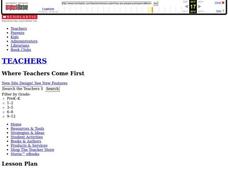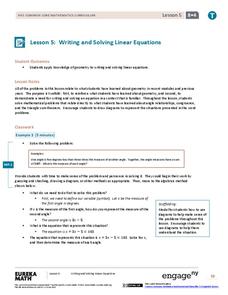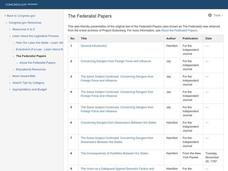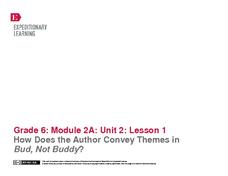Curated OER
Write Some Dialogue
Students write dialogue. For this character development lesson students use direct or indirect speech to include a confrontation between two characters in their story. Students portray the emotions of the characters in addition to what...
Nancy Fetzer's Literacy Connections
Expository Paragraph
Upper elementary and middle school writers learn how to craft an expository paragraph by following the six steps detailed in a 48-page instructional guide. Learners learn how to write six different types of informational paragraphs:...
Minnesota State University
Writing Sample Constructed-Response Assignment
Class members practice their writing skills by completing a prompt about maturity. They develop a constructed response about something they once thought was important, but may not be as important now.
Curated OER
How are People Portrayed by Different Media?
Your 9th - 12th graders can hone their analysis and critical thinking skills by studying the way a subject is portrayed across media types. They examine how various print, visual, and online sources have portrayed key players in the 9/11...
English Worksheets Land
Out to Lunch
Enhance instruction and practice reading with a worksheet that doesn't just ask scholars to identify a sentence's point of view, but also poses the question, How do you know?
Scholastic
Tell Us a Tale: Teaching Students to Be Storytellers
Encourage scholars to retell their favorite short story or folktale, adding personal details to make it their own. After reading their book of choice several times, story tellers retell a tale verbally to their classmates.
Curated OER
Picture This! Building Photo-Based Writing Skills
High schoolers analyze photographs as a development activity for their literacy skills. They will review the 6 Q's feature for analyzing photographs and analyze a variety of photographs and then write comments in the space around the...
Curated OER
Writing Numbers 24-30
Just follow the arrows! Young scholars examine sample numbers 24-30, including arrows to show them how to move their pencil. Then, they trace a lighter image and try a few freehand. At the bottom, they practice the basics by tracing...
Charleston School District
Scientific Notation Operations
How do you operate with numbers in scientific notation? The resource provides examples on how to divide and multiply with numbers written in scientific notation. The handout and video also cover the procedure for addition and subtraction...
EngageNY
Writing and Solving Linear Equations
Incorporate geometry into the solving linear equations lesson. Pupils use their knowledge of geometry to write linear equations which reinforces geometry measurement concepts while at the same time providing a familiar context for...
Poetry Class
Writing a Monologue
The works of Carol Ann Duffy, Scottish poet and Britain's 2009 poet laureate, serve as a model for a writing activity that asks class members to select a character card, brainstorm lists of words, phrases, actions, and items associated...
Read Works
American Government Preamble to the United States Constitution
Observe Constitution Day with a worksheet that delves deep into the who, what, why, when, where, and how of the U.S. Constitution. Scholars read a short informational text then answer 10 questions—short answer and multiple choice.
Curated OER
Blogging to Create a Community of Writers #6: Writing a Review
Looking for a good social media lesson plan for your class? Then, this lesson plan is for you! They study various written reviews, then must choose an item to review of their choice. They can choose from: a book, restaurant, CD/musical...
Curated OER
Writing a Topic Sentence
Here is an inventive, and easy-to-implement lesson on the writing of topic sentences. Learners review what a topic sentence is, practice identifying topic sentences in an informational article, then play a really cool game. All of the...
Curated OER
Farewell to Manzanar
Examine human resilience across two texts with a detailed unit. Over the course of a week, learners will conduct a close reading of excerpts from Unbroken and Farewell to Manzanar. The resource includes clear procedures for reading and...
Scholastic
A Reading Guide to A Wrinkle in Time
Accompany a reading of Madeleine L'Engle's classic tale, A Wrinkle in Time, with a detailed guide equipped with 15 informative and useful chapters. Scholars discover who the author is, why she wrote the book, and crucial story elements...
Buck Institute for Education
Project Template for Letter to Parents
What better way to elicit the support of parents and guardians in project-based learning than with a letter directed to them that details the project, the activities involved, and suggestions for how they can support their learner. The...
Curated OER
How to DO Just About Anything
Learners discover how to use a digital camera and how to make a PowerPoint presentation. They practice good listening skills and hear how to make a "Supa Dupa Egg." They take notes and use them to create an effective, step-by-step...
Curated OER
How To...
Pupils create "how to" presentations using speech skills, the Inpsiration educational software, digital cameras, and iMovie (or similar presentation software) in this technology-based Language Arts lesson plan. The lesson plan includes...
Curated OER
Following Instructions
Get scholars thinking about the scientific process with this fun experiment they can do at home. Learners practice reading directions as they underline each instruction in a procedural paragraph. They create a flow chart and record...
Owl Teacher
Creating a Map to My House
Here is a simple assignment that will introduce your young geographers to location, one of the five themes of geography, through an activity in which they map the directions and lines of latitude/longitude of where they live.
Dorling Kindersley
Question Words
Teaching your primary learners how to ask questions? Then look no further. This worksheet introduces the six essential question words: who, what, where, when, why, and how. Children begin by practicing how to write these words, before...
EngageNY
Writing: Drafting Body Paragraphs and Revising for Language
Begin the drafting phase of the writing process with a lesson plan focused on logically writing three body paragraphs. Then, revise the writing to make it more formal after a teacher-directed mini-lesson plan. Each paragraph highlights...
EngageNY
How Does the Author Convey Themes in Bud, Not Buddy?
After reading up to chapter 12 of Bud, Not Buddy by Christopher Paul Curtis, scholars read chapter 13 and take part in a grand conversation about the author's writing techniques. Pupils discuss how his writing conveyed literary themes...

























